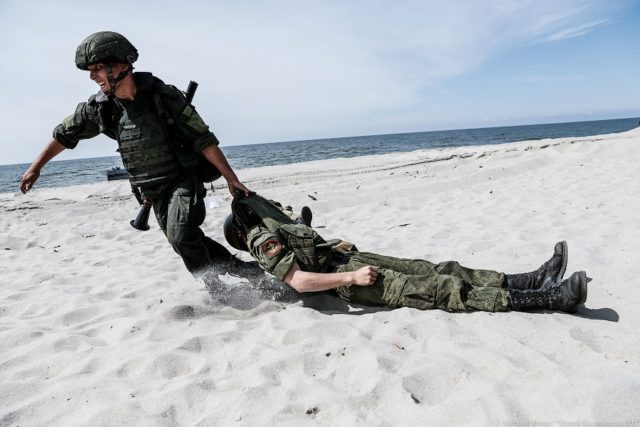
Kaliningrad Oblast: Russia’s Testing Ground for ‘Warfare of the Future?’
Publication: Eurasia Daily Monitor Volume: 14 Issue: 113
By:

Russia watchers had collectively identified Kaliningrad as a serious anti-access/area-denial (A2/AD) “bubble” by 2016 (see EDM, October 12, 2016; Neweasterneurope.eu, August 2, 2017). Now, this westernmost Russian region may be on its way to becoming a training ground where the most advanced methods of warfare will be tested. One such element—reserve-based “territorial defense units”—is already being experimented with and implemented there.
On August 30, local media outlets announced that the process of registering reservists (including individuals who had never served in the Russian Armed Forces) to participate in military call-ups (“voyenniye sbori”) had been underway in the oblast (and local municipalities) for “at least one week.” It was also added that the military formations assembled from these local reservists might take part in the approaching Zapad 2017 strategic-level exercise (Newkaliningrad.ru, August 30). Meanwhile, the Kaliningrad authorities (both military and civilian) have largely stayed silent, refraining from commenting on the matter.
Bits and pieces of information assembled from local media reports shed some light on the ongoing developments in Russia’s Baltic exclave. Interviews with reservists (who prefer to remain anonymous) reveal an atmosphere of secrecy surrounding the military call-ups. Namely, all reservists were compelled to sign a document pledging the non-disclosure of “classified information.” Another curious detail that has emerged is that no one is immune from selected: employees (35–40 years old) of major businesses/organizations located in the oblast are now receiving letters demanding they “be ready for military call-ups.” The periods of mobilization as well as the number of employees to be recruited in this manner were not specified, and business leaders in Kaliningrad are offering no details to their workers who could be affected (Newkaliningrad.ru, August 30, September 8).
Arseny Levinson, a local human rights activist and a representative of the civil society initiative “Citizen and the Army,” commented that “virtually every local resident is a potential participant of these military mobilization operations—even those who cannot carry out active duty due to health issues or who never served [in the Armed Forces] because they had already passed the maximum service age limit of 27 years” (Bezformata.ru, August 30). Available data suggests that Kaliningrad is not the only place where such reserve call-ups are being carried out. Some sources reported that similar developments are occurring in Pskov oblast (Mk-pskov.ru, August 27). This is not entirely surprising, considering that President Vladimir Putin specifically signed a decree on reserve mobilization in April of this year (Pravo.gov.ru, April 20).
Since the collapse of the Soviet Union, the first large-scale military call-up of reservists in Russia took place in August–October 2014, which coincided with the most decisive stage of the military confrontation in southeastern Ukraine. During this period, significant numbers of personnel (the actual figure was never disclosed) and various specialists took part in the Vostok (East) 2014 war games (Rusplt.ru, August 1, 2014). The following year, in 2015, reserve mobilization exercises reached an even greater scale and were linked to “the generally tense political environment in the world and the situation in Ukraine in particular,” according to Russian journalist Liza Dubrovskaya (Moskovsky Komsomolets, February 5, 2015).
This, however, is not the only element that should be taken into consideration. Perhaps even more importantly, on August 31, local media announced that the authorities were planning to create in Kaliningrad oblast “territorial defense units” (podrazdelenia territorialnoii oboroni), specifically composed of reservists (both privates and officers). The idea, apparently, is to create a full division that will be permanently stationed on the territory of the oblast. It will likely take part in the Zapad 2017 exercise happening now (September 14–20). Based on available details, the primary task of these formations will be concerned with anti-terrorism activities (Newkaliningrad.ru, August 31).
Regarding the concept of “territorial defense units,” it is worth remembering that the notion received critical impetus in 2014, related to two main factors. First, the outbreak of the war against Ukraine enabled the Russian side to further bolster its pre-existing military build-up. Second, and perhaps more importantly, the development of the concept reflected Russia’s growing concern about new types of warfare and military operations (so-called “warfare of the future”), including informational and cyber warfare, which are seen by Russian military strategists as a “precursor to hostile civil wars and external interventions” (Nezavisimaya Gazeta, March 21, 2014). Russian military experts rightfully assume that military engagements along a classic front line have not lost their crucial role in modern warfare. Yet, the emergence of new technologies and means of combat (as explicitly demonstrated in the course of Russia’s involvement in Ukraine and Syria) have underscored the essential need to also protect a state’s peripheral areas by using “territorial defense units.” This is by no means a new phenomenon for Russian military practice: its prototype emerged in the Russian Empire in 1864, and continued throughout the Soviet period, though remaining mostly at the margin of attention. However, Russian perceptions regarding territorial defense started to change from 2003, under the influence of the disastrous defeat of the Iraqi Armed Forces during the United States’ invasion of that country. Iraq was unable to organize a proper territorial defense, which, in many respects, became the Saddam Hussein regime’s death warrant. Later events in Libya, Syria and Ukraine simply underscored this point in the Kremlin’s eyes. In 2016, “territorial defense units” consisting of military reservists were formed within the Russian Northern Fleet (TASS, August 31, 2016).
In conclusion, the emergence of such formations in Kaliningrad should not be exclusively reduced to preparations for Zapad 2017. Rather, this step appears logical in light of Russia’s previous steps aimed at the comprehensive militarization of the region. It seems the next stage—the achievement of a qualitative breakthrough in such areas as electronic warfare as well as cyber and information operations, coupled with universal militarization—is now being implemented.



